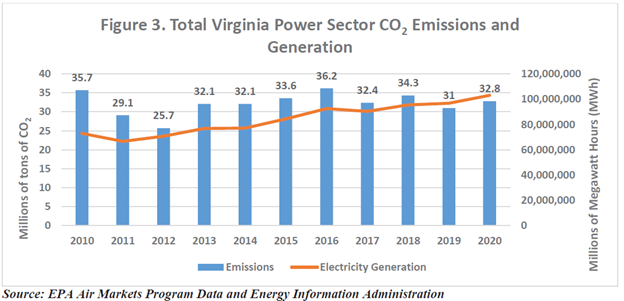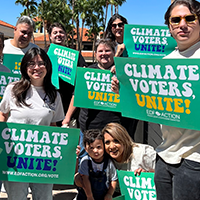Virginia Governor Youngkin is wrong about RGGI. Here's why
Authored by Mandy Warner, EDF Action Virginia Director
This tense time for national security is once again showing us the danger of our reliance on fossil fuels. Since oil and gas are sold on a global market, prices can spike wildly any time there is global instability. That is why in the long run, as many national security experts have pointed out, energy security for Virginia and the rest of the country can only truly be achieved by ramping up homegrown, cheap, clean energy that’s made in the U.S. and stays in the U.S. It is the right move for ensuring affordable energy, protecting our public health from toxic air pollution and for achieving a stable climate.
While leaders should take necessary measures to ease the cost burden that many Virginians are feeling at the pump and through global inflation, they should not leverage this painful moment to launch partisan attacks on our critical climate, health and security goals – but that is exactly what Governor Youngkin is trying to do right now.
Last week, Governor Youngkin released a misleading and flawed report that attempts to paint the Regional Greenhouse Gas Initiative (RGGI) – a proven, market-based program in 11 states that’s lowering climate pollution from power plants – as unnecessary, despite evidence contained in the report that underscores the need for a program just like it. This report brazenly skirts key issues and uses misleading data to attempt to justify another one of Youngkin’s unpopular policies: pulling Virginia out of RGGI and halting climate action.
Here are 5 main points about RGGI and the report that show how the Youngkin administration is completely off-base with their determination to remove Virginia from RGGI:
1. RGGI has a track record of success. Although Virginia just joined in 2021, RGGI has been operational for over a decade and has cut climate pollution from power plants in half in participating states. These historic reductions in climate pollution have been achieved twice as fast as the nation as a whole. Currently, 11 mid-Atlantic and Northeastern states – both Democrat and Republican-led – participate in RGGI, and are leveraging this flexible, market-based approach to driving carbon emissions down in ways that suit the needs of each state. In fact, Youngkin’s own RGGI report acknowledges this success, saying “…CO2 emissions have decreased in the RGGI participating states by 59% from 2005 to 2020.” There is no reason Virginia cannot see substantial pollution reductions from this program with proper leadership.
2. Virginia communities are counting on RGGI funds for flood resilience and energy efficiency. By compelling polluters to pay for their pollution, RGGI provides proceeds that can be invested back into communities. The Youngkin administration’s report pays little attention to the fact that Virginia has raised $228 million in investments, which fund energy efficiency projects in low-income households and vital flood resilience in communities from Roanoke to Alexandria. RGGI provides the only dedicated source of state funding for flood resilience, offering a critical defense to mounting flood threats across the state right now. Gov Youngkin’s efforts to pull Virginia out of RGGI would strip away this lifeline that local governments are relying on, especially under-resourced, small and rural communities that do not have the capacity to address flood risk on their own. With precipitation expected to increase across the commonwealth by 20% in the next 40 years and nearly 1 million Virginians at risk of coastal flooding by 2080, we can’t afford to lose these crucial resilience investments.
3. Virginia needs to get its emissions in check. Without a program like RGGI, it is unclear how Virginia will meet its own, science-based climate goals. According to the state’s Department of Energy study of the Virginia power sector, as noted by Youngkin’s report: “ an emission reduction program or combination of programs will be required to meet the Commonwealth’s climate goals of the VCEA and the 2045 net-zero carbon emissions goal. In the absence of any such program, emissions may not reduce sufficiently to achieve these goals.” And the last ten years of total pollution from the power sector paints a pretty clear picture: we need binding policies in place, like RGGI, to drive down power sector pollution for good.

4. The public supports action on climate and RGGI specifically. A recent poll showed that 67% of Virginians support remaining in RGGI. Additionally, polling by EDF Action found that 61% of voters say climate change is already having a serious impact on Virginia. Clearly, Gov Youngkin’s actions on RGGI are out of step with the majority of Virginians.
5. Electricity rates in Virginia have been rising for years. Ramping up clean energy and efficiency will lower costs in the long run. While the Youngkin administration wants to put the blame on RGGI, Virginians have historically had some of the highest average monthly residential electricity bills in the nation. In 2020, Virginians paid on average $131.72 per month for residential electricity – almost $15 above the national average, and $9 above the RGGI region average. Monthly residential bills depend on not just the cost of electricity, but the amount of energy being used, the costs for distributing and transmitting power, and taxes, for example. Virginia has relatively low electric prices, but residents face high monthly bills; whereas, Maryland has a higher electric price than Virginia, but monthly bills are lower.
Many RGGI states have successfully leveraged RGGI proceed investments to lower electricity bills by investing in energy efficiency improvements. Virginia currently has the highest average monthly electricity consumption in the RGGI region and has ample opportunities for investing in efficiency and lowering residential bills.
Furthermore, fossil fuels are inherently volatile because they depend on global supply chains and markets. Ratepayers may be inherently subject to swings in fossil fuel costs for power plants reliant on them as those fuel prices are sensitive to a variety of factors, including geopolitical issues. However, fuel costs don’t change for wind- and solar-powered electricity over time because the wind and sun are free, and many renewable projects are offering cheaper electricity than even running existing fossil fuel plants. In short, RGGI is not the source of Virginia’s electric ratepayer woes. Virginia needs leadership at all levels to align on commonly shared goals of protecting ratepayers and delivering the clean, competitive grid of the future that will save Virginians money in the long run.
Prior to Governor Youngkin’s arrival to office, Virginia was making critical progress on climate action – reducing emissions and preparing communities for unavoidable climate impacts through RGGI – but now that progress is at serious risk. It seems clear that Youngkin’s administration has no interest in addressing climate change, despite large, bipartisan majorities and major businesses supporting action in Virginia. Instead of working to tear down a proven program, Youngkin could reset his Administration’s concerning start out of the gate and follow the lead of countless governors, legislators, businesses, and others who are working to reign in climate pollution and ensure Virginia is part of the solution.
TAKE ACTION: Call on Gov. Youngkin to stop attacking the Regional Greenhouse Gas Initiative



